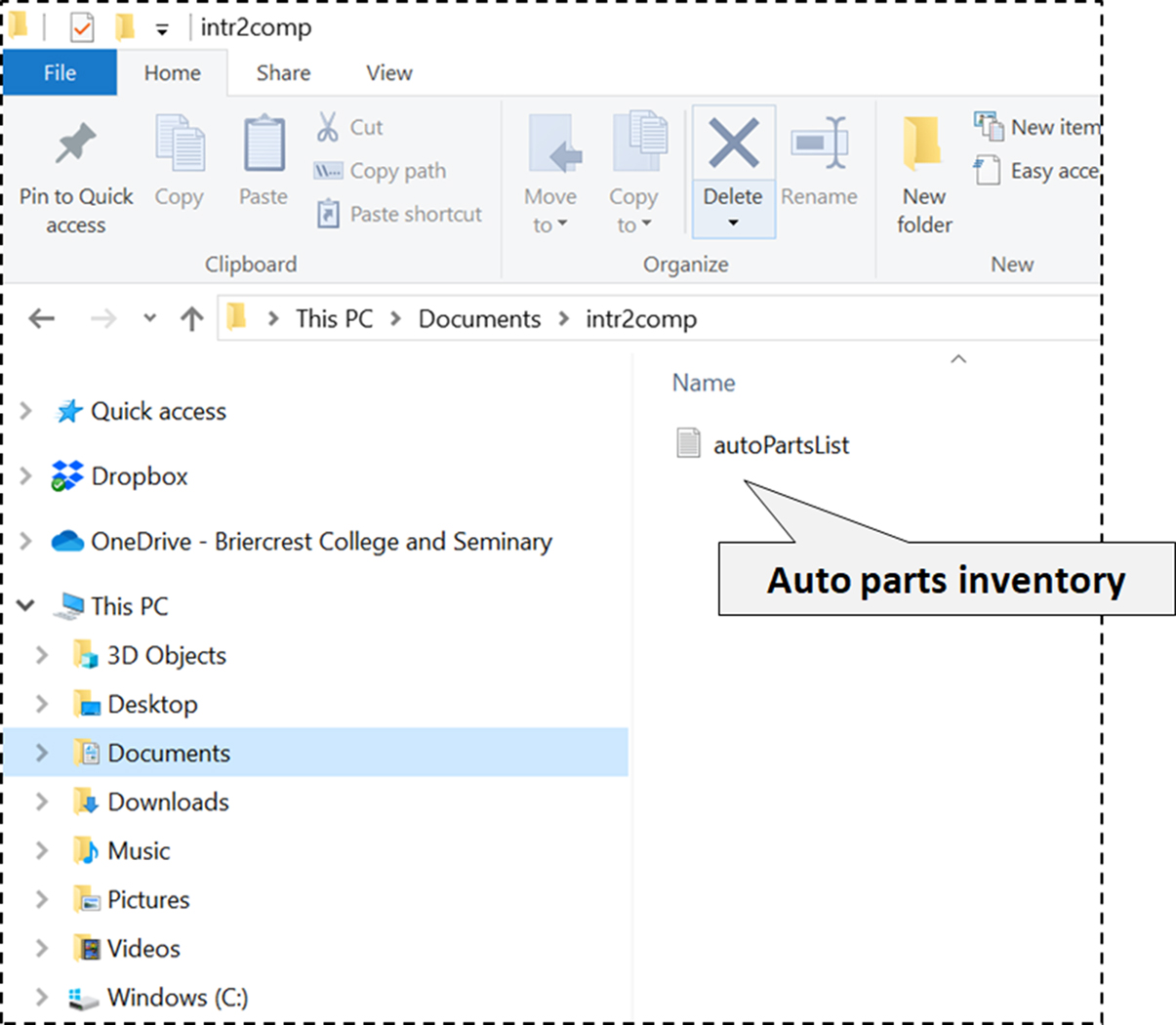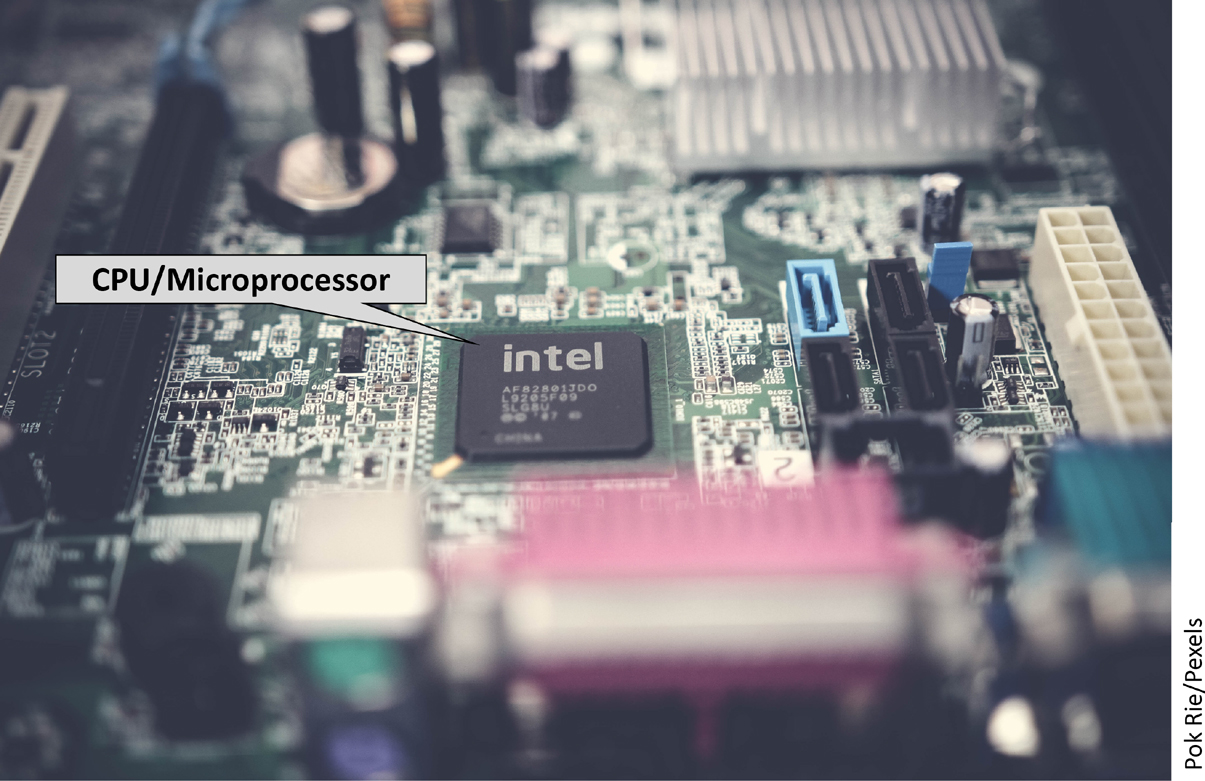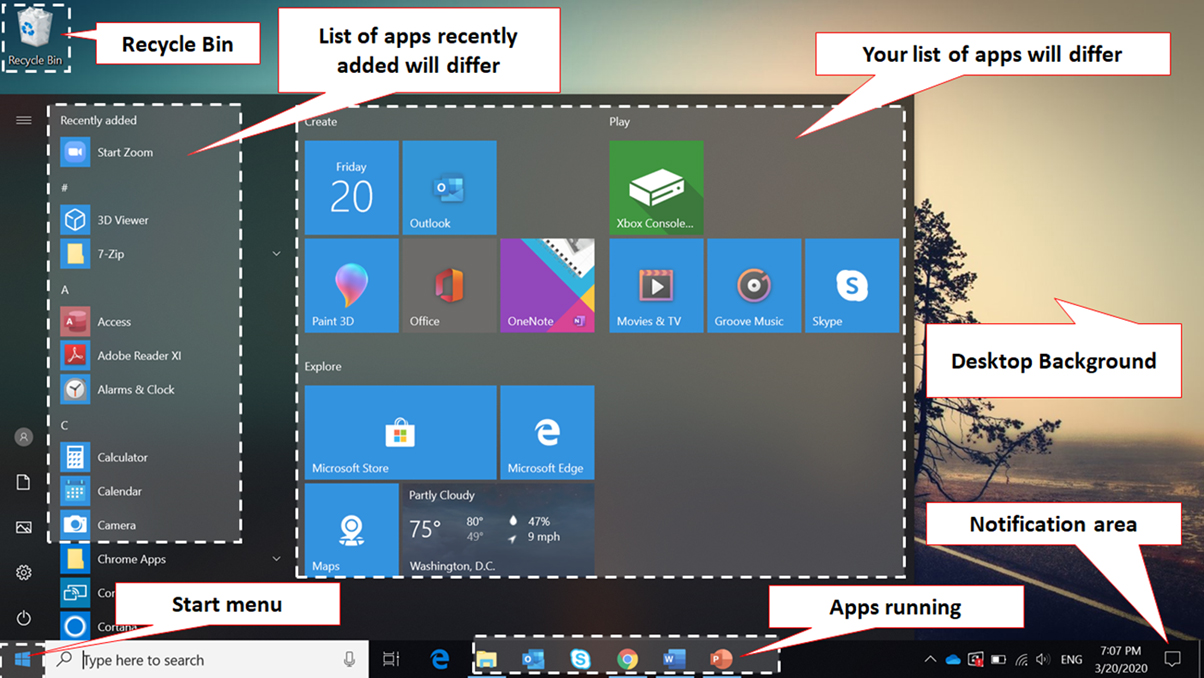IT Infrastructure: Hardware and Software
Learning Objectives
• Describe hardware
• Identify the main components of hardware
• Describe input and output devices
• Describe software
• Understand the most common operating systems
• Work with Windows 10
• Explore file management
In Chapter 2, you learned that almost everything played every day for any organization will include some use of computer systems. Nowadays, companies are looking for ways to automate any remaining manual process to get more efficiency.
You also learned what a computer is and how you can use it in your daily life. This chapter goes more deeply into the computer system understanding and finds the answer to the question: What hardware and software are, and how they work together?
Chapters 1 and 2 gave you the notation of the importance of computer systems for the companies. From the business side, it is crucial to have a robust and powerful information technology infrastructure. Therefore, it is necessary to know computer needs and understand its components. A comprehension of hardware and software will give the manager the right notion and base to support decision making related to computer systems acquisition, maintenance, or upgrade.

Figure 3.1 Computer and its peripheral devices
Source: Icon made by Pixel perfect from www.flaticon.com
The main tasks performed by computers are input, processing, output, and storage. A computer system needs different components to execute each of these tasks. The computer itself is the machine responsible for process data. However, it requires additional components called peripheral devices to perform the input, output, and storage functions (Figure 3.1). All these physical components, including the computer device itself, are hardware.
According to Esteras, in a computer system, the hardware is any electronic or mechanical part you can see and touch (Esteras 2013).
Identify the Main Components of Hardware
Inside the computer case, that is, a metal or plastic box, you can find the main components of a computer system. There are the motherboard, central processing unit (CPU), and power supply. The motherboard is the main circuit board of an electronic device, and this board holds the CPU or microprocessor as well as other chips and circuits (Figure 3.2). The CPU is called the brain of the computer. The main reason relies on the fact that this microprocessor controls all function and processes all commands of a computer.
Figure 3.2 Motherboard and its CPU
Source: Pok Rie/Pexels
In 1971, Intel introduced the first microprocessor called Intel 4004. Nowadays, as explained by Moore’s law, a microprocessor is smaller and powerful than its predecessors. Usually, about a 2-inch square, made of ceramic, covered by a heat sink, the microprocessor fits into the CPU socket located in the motherboard. Working in speed measured in megahertz (MHz) or gigahertz (GHz), the CPU selects instructions to be processed, performs arithmetic and logical comparisons, and stores the operation results in memory. This work at high speed is possible because a CPU is composed of several components. These components are the control unit (CU), arithmetic logic unit (ALU), floating-point unit (FPU), decode unit, cache memory, prefetch unit, registers, clock, bus, and instruction set. Figure 3.3 shows a diagram illustrating how a CPU works.
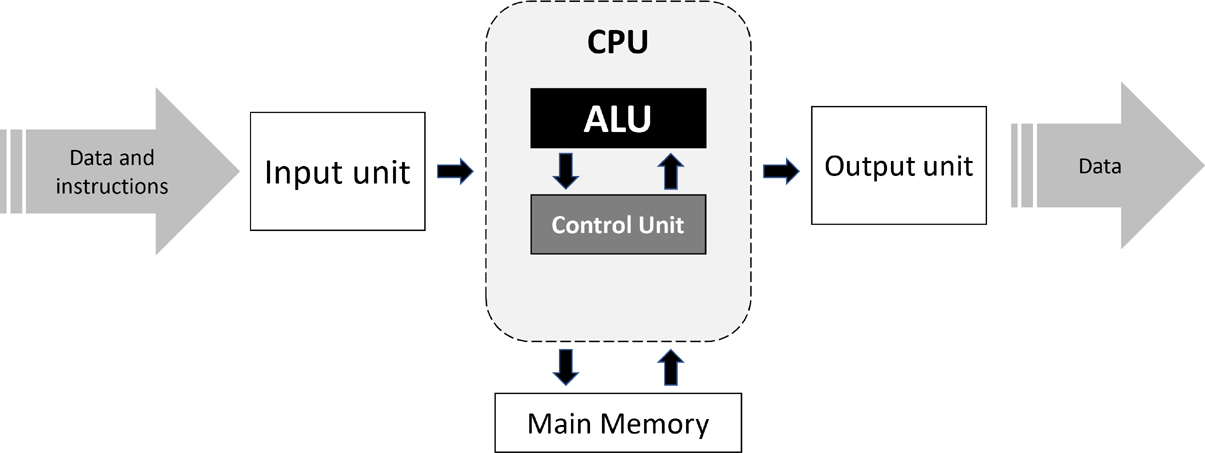
Figure 3.3 How the CPU works
Figure 3.3 shows the CPU receiving data and instructions from the input unit and organizing those in a fetching queue. Those instructions are processed, calculated, organized, and stored as part of the CPU processing work. Then, the resulting data are outputted through the output unit.
When a computer is turned on, it needs a set of data and instructions saved previously. These data and instructions stored in the read-only memory (ROM) begin the initial computer startup process. While in use or running, lots of tasks are performed by applications like games, word processors, Internet browsers, and so on. These processes need additional memory for execution, and this extra memory is called random-access memory (RAM).
ROM chips defined by the manufacturer are usually an integrated part of the computer motherboard. However, you can find expansion ports on the motherboard to replace or add RAM chips. The RAM chip capacity of storage is measured in gigabytes (GB).
If your computer is slow, before deciding to buy another one, maybe you could save some money just making an upgrade. Upgrading your computer means to replace the microprocessor with another one faster and add more RAM chips. It is a wise and economical way to extend the life of your computer.
A computer is an asset for companies and requires financial investment. Eventually, because of an increasing amount of data to be processed, the company needs more computer capacity. Working under a financial budget limit will require more from the manager about information technology investment. In this case, understanding how a computer is made of and how it works is very useful. In some situations, instead of replacing computers with new ones, the manager could consider the possibility of just upgrading microprocessors and RAM chips.
Describe Input and Output Devices
As learned, a computer is an electronic device developed to process data. There are too many things a computer can do and ease our life. However, to be an efficient tool for people needs, interactions are essential. This interaction means that people should have a way to enter data into computers and get back results from the processed data. It is the primary function of input and output devices. They serve as an interface between a human and machine. A keyboard is the most basic input device used to type and enter data into a computer. Also, the monitor is another primary output device used to show processed data to computer users. Go back to Figure 3.1 and take a look at some commons input and output devices.
A list of most common input devices would include the keyboard, webcam, mouse, scanner, microphone, joystick, and touchpad, to mention a few. On the other hand, the most common output devices would include the monitor, printer, projector, speakers, headphones, and others.
If you pay close attention, you will discover that all those devices have the objective to help us to communicate with computers. For this reason, they explore basic human senses like touch, sight, and hearing. The design and form are usually ergonomic to offer the most comfort possible for the users.
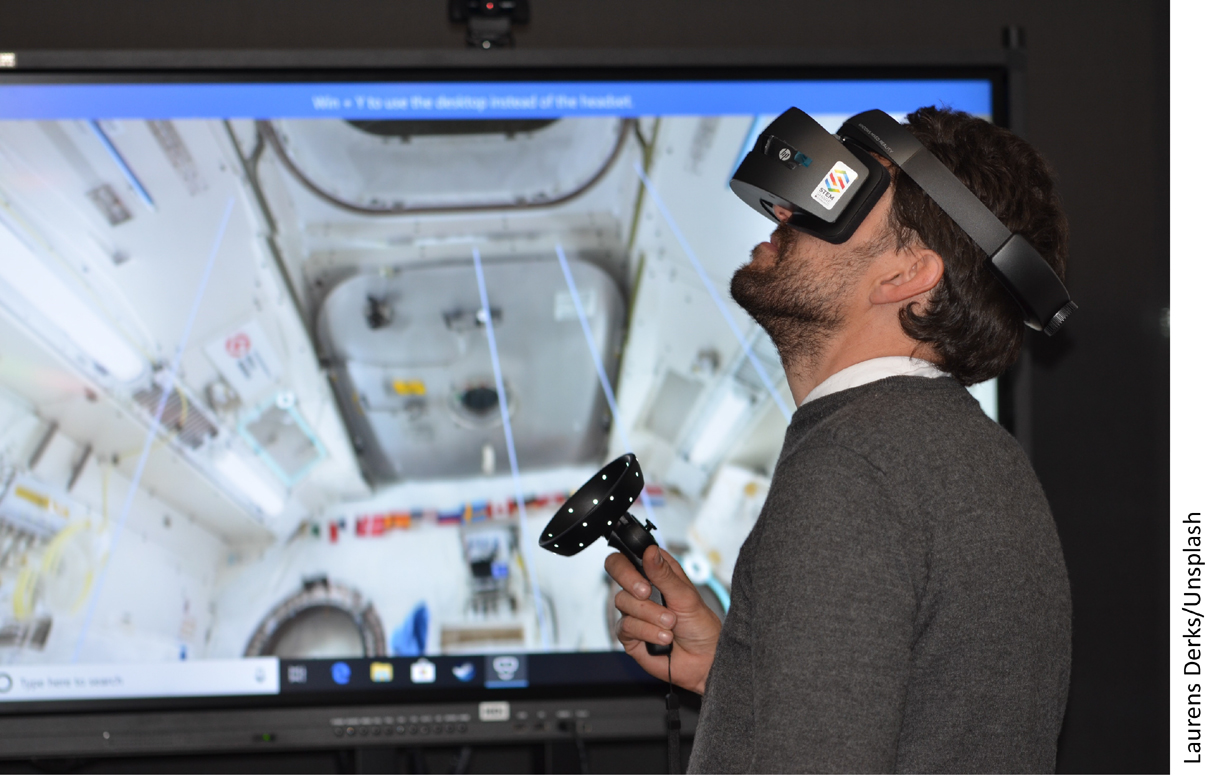
Figure 3.4 VR headset
Source: Laurens Derks/Unsplash
A virtual reality (VR) headset is a head-mounted device used to give the users an experience of artificial environments as being in the real world (Figure 3.4). It is an immersive experience. There are too many applications for VR like education, entertainment, medicine, architecture, military, and others.
Have you heard the term digital native before? This term does not refer to a particular generation, but an individual who was born in general after 1996 that marks the widespread adoption of digital technology. However, it does not means all children born today are digital natives. What defines a digital native is the interaction since early ages with technology.
We are living in an era of information and technology as part of our life. Computer systems are everywhere, and everybody at different levels is a computer user. However, computers are sophisticated devices, and in general, users do not understand how programs and utilities help computers run.
Those programs and utilities that help computers run are called software. In short, the software is a set of instructions telling hardware what to do and how to do it. Any program in your computer or apps on your smartphone is software. Games, Internet browsers, Microsoft Office, and Internet banking are examples of software.
There are different categories for software, depending on its purpose. The most common groups of software are operating systems, system utilities, and applications (Figure 3.5).
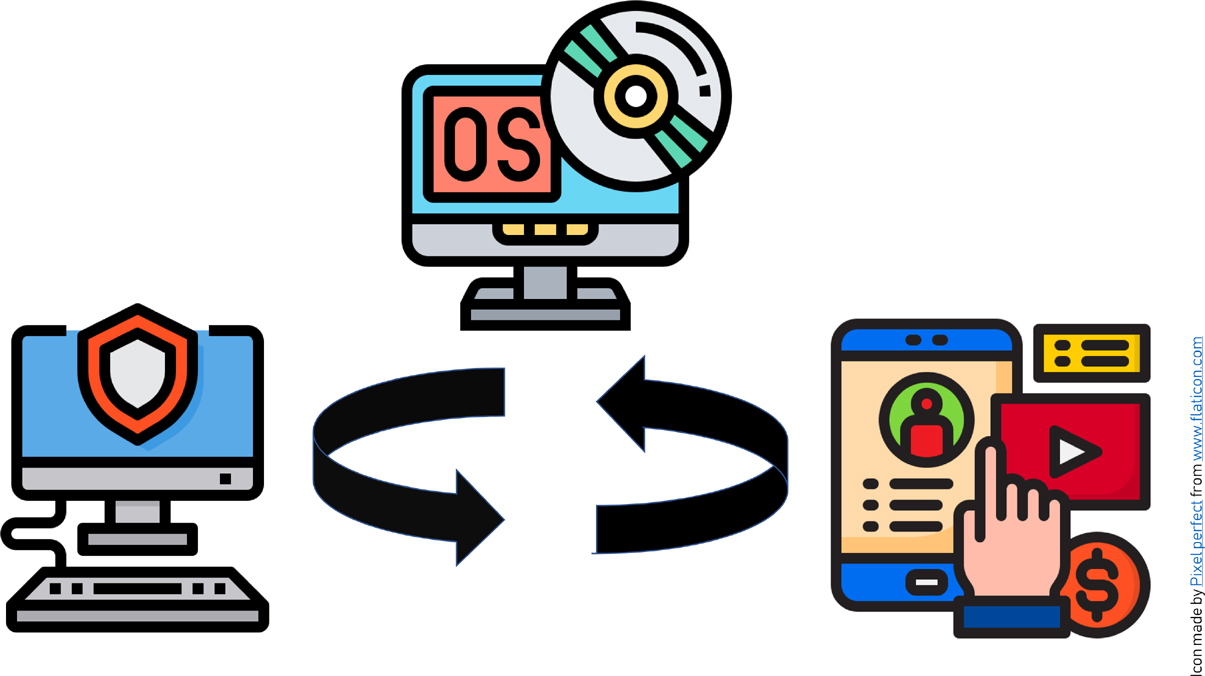
Figure 3.5 OS, system utilities and applications
Source: Icon made by Pixel perfect from www.flaticon.com
An operating system (OS) is an essential software responsible for managing and controlling all the programs on your computer device. This program provides the user interface to communicate with the hardware and other software on your computer. Also, it is the OS that controls all functions in your computer, like reading and writing data, memory allocation, program execution, error controls, and backup. How hard or easy will be the interaction with your computer will depend on a large part of the OS running.
System utilities are programs developed to help in the maintenance, repair, and protection of your computer. Some program utilities come with your OS. However, you can acquire and install additional system utilities on your computer. An antivirus program is an example of software utility frequently bought and installed additionally on computers.
Application software, application, or just app, is a group of software developed to help users with their most common daily tasks. This group of software includes a word processor, spreadsheet, business application, e-mail, media player, photo editor, Web browser, and much more. Microsoft Office is a suite that includes a list of different software applications used by companies. In this book, you will have the opportunity to learn how to work with the most used Microsoft Office applications.
Understand the Most Common Operating Systems
OS is the main program that defines how a computer device interacts with users, stores and manages files, runs different applications, manages memory, and lots of other functions. There are different OSes for different computers devices. Is your computer a PC, Mac, Tablet, or smartphone? Each of these computer devices comes with a specific OS. The most common OSes are Windows, macOS, Android, and Linux (Figure 3.6).

Figure 3.6 Most commons OSes
Source: Icon made by Pixel perfect from www.flaticon.com
Microsoft Windows is so far the most popular OS for PCs, residing on more than 95 percent OSes of the world’s desktops. Windows 10 is the latest version of Microsoft OS, and it is possible to find a version for desktop, laptop, tablet, and smartphone. Because Microsoft Windows is a commercial software, some users prefer to have in their computer an open-source OS. This type of OS can be installed on a computer for free. The most popular open-source OS is Linux.
Developed by Apple, macOS X is the Macintosh operating system. It is an OS based on the Unix development language create to run on desktop and laptops manufactured by Apple. The company developed an intuitive and responsive mobile OS for its iPhone and iPad devices called iOS.
In terms of the number of users, Android is the most popular OS for smartphones and tablets. Developed by Google, Android has evolved continuously and has been installed in various devices from different manufacturers. Today, Android is a mobile OS standard for smartphones and tablets.
Work with Windows 10
If you are part of the 95 percent group of PC or desktop users around the world who have Microsoft OS, probably you are familiar with Windows 10. However, if you are part of the other group, probably macOS, or even if you just use your tablet or smartphone as a computer device being an Android user, you still may know about Windows 10. The reason is straightforward when you start to work in a company. The probability of you having to work on a computer with Microsoft OS like Windows 10 is very high.
To work on a computer with Windows 10, you will need a Microsoft account to log in to the OS through your account. Your Microsoft account includes a user name or e-mail and a password. Once you have logged in, you will see the desktop area or the main workspace for your computer (Figure 3.7). That is your start point to manage files, view e-mails, access the Internet, open applications, and much more.
Figure 3.7 Windows 10 workspace
The Windows 10 workspace is dynamic. Its appearance will vary depending on how you use your desktop, installed applications, and personal configurations. However, there are some common elements to note. Your initial view usually is the big area named Desktop background, an icon on the left-top called Recycle bin, and a bottom-taskbar with a Start button menu at the bottom-left corner.
Click on the Start menu in the bottom-left corner of your screen to open programs, files, and settings. When you do that, a new window will open with areas where you can find files and applications. Those group areas could be Most used, Recently added, Life at a glance, Create, Play, and Explore.
When working with your Windows 10, you can find meaningful information on your bottom-bar like apps running, hour time, date, and notifications.
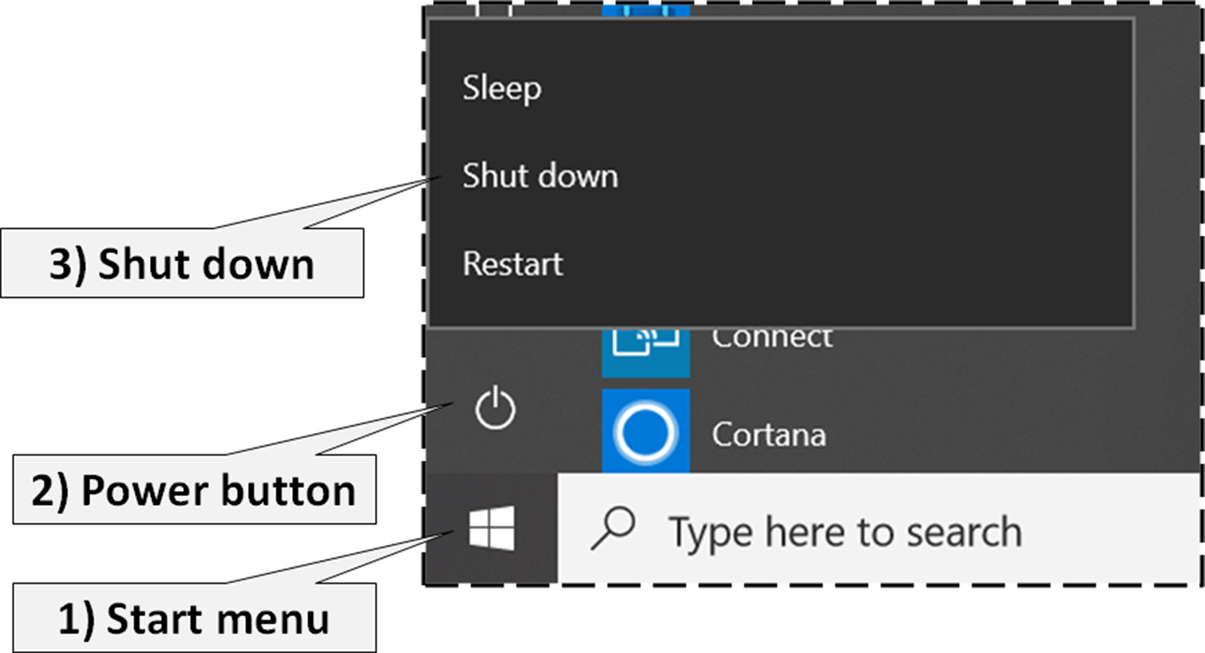
Figure 3.8 Windows 10 shutdown
Are you done using your computer? So, you can shut it down correctly (Figure 3.8). Just click on the Start menu, then choose Power > Shut Down.
Explore File Management
One of the most important things you can do when working with computers is file management. No matter what your position is in an organization, you also have to handle files. We can define the file as a digital collection of information stored on computers under a single name. Working with files means to create, open, close, save, name, delete, and organize them. The files can be organized into a folder structure that allows you to navigate through that structure. In Windows 10, the application called File Explorer is the program used to manage files and folders.
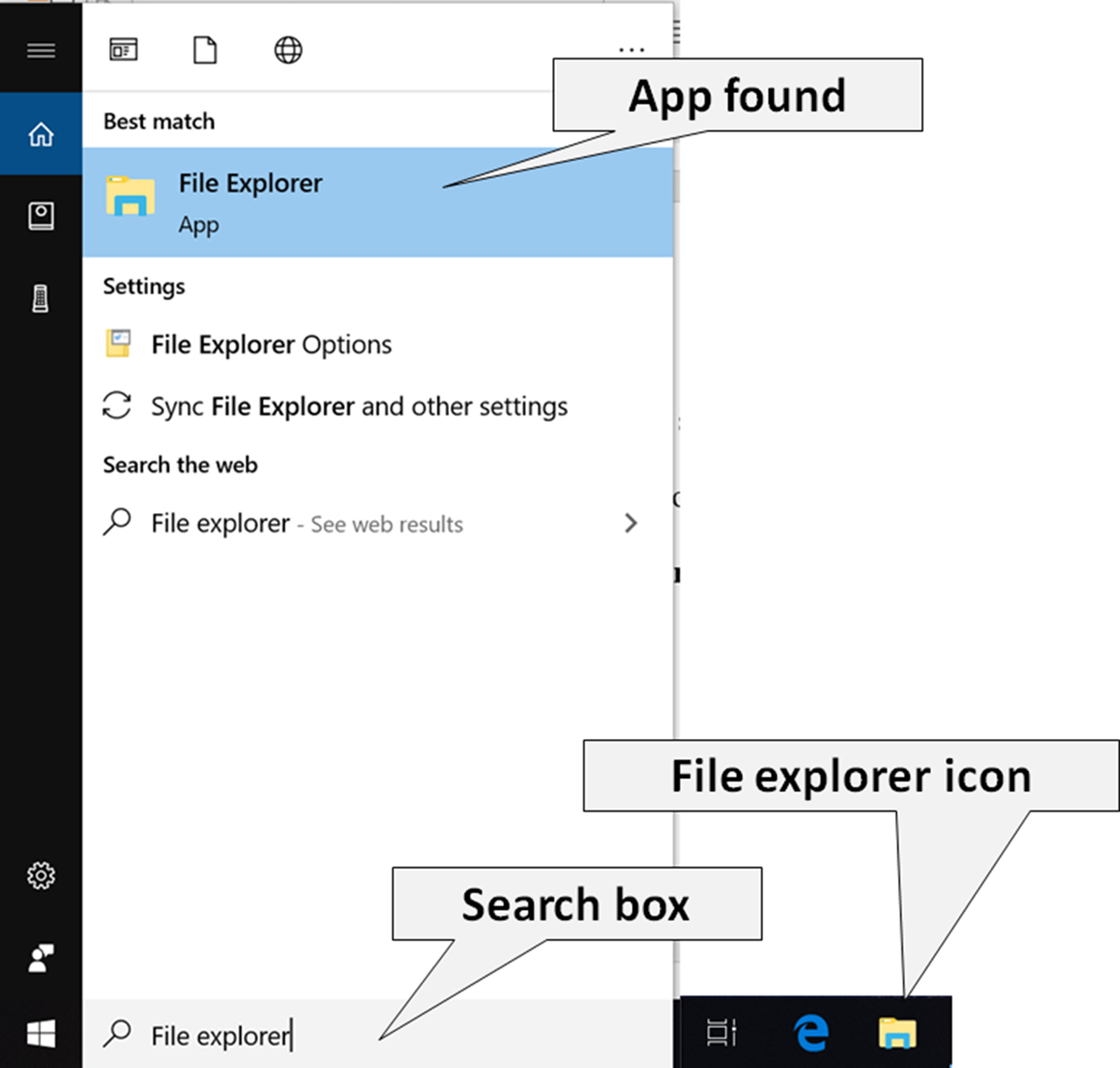
Figure 3.9 Opening File Explorer app
To open the File Explorer application, you can click on the File Explorer icon on the taskbar (Figure 3.9). Another way is just typing File explorer in the Search box. Once the app is found, just click on it to open the program.

Figure 3.10 File Explorer
Use the Navigation pane to navigate between files, folders, drivers, and network. You can collapse and expand drivers and folders that include Quick access, OneDrive, This PC, and Network. Click on any of these items to list its contents on the right side. Also, you can use the Search box to find a file. When you select an item, the Ribbon will show the options related to the chosen object. Those options, depending on the selected item, can be properties, cut, copy, rename, delete, and so on.
Tech Article: Tips to Keep Your Computer Running Smoothly

Figure 3.11 Keep your computer running smoothly
Source: NewsUSA
(NewsUSA)—Buying a new computer’s always a thrill—but sooner or later, your fast new machine will start to act like a clunker. Or will it?
With a few simple tips, you can keep your computer running smoothly. Sammsoft (www.sammsoft.com), a company that develops and publishes quality software products designed to secure, protect, maintain and enhance computer users’ experience, provides the following tips:
1. Clean out your computer registry. Every Windows Operating System uses a registry or a central database that contains all of the settings for low-level operating system components, as well as any applications running on the platform. Every time you save something, run a new application or install or uninstall a program, new information is organized into your registry. But occasionally, the registry records something incorrectly. Over time, registry errors pile up and can start slowing down your computer. But running a registry cleaner, such as Advanced Registry Optimizer 2010 by Sammsoft, will fix registry errors and remove faulty files, helping your computer run quickly and smoothly.
2. Keep viruses under wraps. Run a virus checker regularly. If you have a high-speed wireless connection, don’t use the Internet without a firewall. No antivirus strategy is perfect, so stay away from suspicious-looking Web sites and don’t click on strange links in e-mails.
3. Get rid of unnecessary files. If you haven’t used a program in months or years, delete it to reclaim valuable memory. But always back-up applications in case you want to reinstall them later, and don’t delete applications that you don’t recognize, as Windows might need them to run. Never remove WINDOWS or HOT FIX applications. Also, delete cookies and clear your Internet cache before you sign-off your computer.
4. Never turn off your computer before Windows has shut down. Doing so could harm the hard drive or result in lost data or Windows files.
5. Back up Your Computer. Hardware problems occur more than you might think, and you don’t want to deal with the frustration of losing valuable data. Back up photos, Excel spreadsheets, Word documents—anything that you do not want to lose—on external hard drives or CDs.
For more information, visit www.sammsoft.com.
Summary
• Hardware is any electronic or mechanical part you can see and touch.
• Software is a set of instructions telling hardware what to do and how to do it.
• Application software is a group of programs developed to help users with their most common daily tasks.
• Microsoft Windows is so far the most popular OS for PCs.
• One of the most important things you can do when working with computers is file management.
• We can define the file as a digital collection of information stored on computers under a single name.
1. Explain how a computer works.
2. Define hardware and software.
3. What is the difference between RAM and ROM?
4. “A computer with more processing power can store more programs.” Why is this statement not valid?
Windows 10 Project: Creating a New File
It is your first day at Mechanic Hills in the Parts department. Mrs. John, the parts manager, asked you to create an inventory of auto parts. Going to the stock, you found two bonnets, five bumpers, seven cowls, four wipers, and eight disk brakes. Using the File Explorer, you will create a new folder called intr2com into the Documents folder. After getting the new folder done, you will create a new file called autoPartsList txt using the Notepad program.
Instructions
1. Open the File Explorer.
2. In the Navigation pane, select This PC > Documents.
3. With the folder Documents selected, go to the Ribbon and click on the option New folder.
4. Type intro2com for the folder name and press Enter on your keyboard.
5. With the new folder selected, go to the Ribbon and click on the option Open.
6. On the taskbar, type Notepad in the Search box.
7. Click on the Notepad app.
8. Type the auto parts list into the Notepad.
9. On the menu, select File > Save.
10. On the pop-up window, go to the Navigation pane and find the folder intro2comp (Figure 3.12).
11. Type autoPartsList txt for the File name.
12. Click on the Save button.
13. Close the Notepad program.
